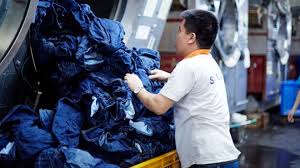完美的牛仔褲
Until the 1970s, a good many jeans sold had been made of stiff, shrink-to-fit—or "unsanforized"—denim. To soften them, you simply had to wear them. A lot. It took a good six months to properly break in jeans. After a couple of years—years—the hems and pocket edges might start to fray, or a knee would split open. The fabric faded to a powdery blue with some whiskering—the sunburst-like streaks that radiate from the fly. Time and dedication were required to push your jeans to peak fabulousness.
直到20世紀70年代,很多出售的牛仔褲都是用堅硬的、經過收縮以適應環境或未經打磨的粗斜紋棉布制成的。要軟化它們,只需要穿上身。很多次。我花了整整六個月才把牛仔褲穿得軟硬剛好。幾年之后,邊緣和口袋邊緣可能會開始磨損,或者膝蓋會裂開。織物褪成了粉末狀的藍色,帶著一些拂動——從蒼蠅身上放射出的曬斑般的條紋。把你的牛仔褲穿到極致需要時間和投入。
That is, until the popularization of stonewashing in the 1980s. Unsanforized jeans were thrown into industrial washers with pumice stones and tumbled until the denim was sufficiently abraded. (The L.A.-based casualwear company Guess famously had a system that stonewashed jeans for seven hours—a marathon now considered an environmental horror.) Sometimes jeans were further distressed with acid, sandpaper, rasps and files to mimic the previously hard-won wear and tear. The entire operation was christened "finishing" and conducted in "washhouses," sprawling facilities that now process thousands of jeans a day.
直到20世紀80年代石磨的普及。未打磨過的牛仔褲用浮石扔進工業洗衣機里,不斷翻滾,直到粗斜紋棉布充分磨損。(洛杉磯總部位于美國的休閑服裝公司Guess有一個著名的系統,就是把牛仔褲打磨七個小時——現在看來,這是一場馬拉松式的環保災難。) 有時,牛仔褲還會被酸性物質、砂紙、銼刀和銼刀弄得更舊,以模仿之前的磨損。整個過程被命名為“整理”,在“洗衣房”里進行。洗衣房占地面積很大,如今每天要加工數千條牛仔褲。

Some washhouses—especially those in Los Angeles, America's jeans-finishing center—are highly technical and follow strict worker safety and environmental norms. But a lot do not, as I saw in Ho Chi Minh City on a steamy April morning in 2018.
一些洗衣房——尤其是美國洛杉磯的那些——是高度技術性的,并且嚴格遵守工人安全和環境規范。但很多都不是這樣的,正如2018年4月一個悶熱的早晨,我在胡志明市看到的那樣。
A largely agrarian economy only 15 years earlier, by 2018, there were roughly 6,000 textile and garment production companies in Vietnam, employing 2.5 million workers, and accounting for about 16 percent of the country's exports and more than $30 billion in revenue. Experts believe that last figure will jump to $50 billion by 2020.
就在15年前,越南還是一個以農業為主的經濟體。到2018年,越南大約有6000家紡織和服裝生產公司,雇傭了250萬名工人,占越南出口的16%左右,收入超過300億美元。專家認為,到2020年,最后一個數字將躍升至500億美元。
譯文由可可原創,僅供學習交流使用,未經許可請勿轉載。












